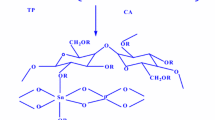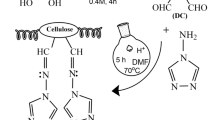Abstract
Thorium reclamation was studied using nano-iron oxide-impregnated cellulose acetate beads to gain insights into the adsorption mechanism, kinetics and thermodynamics. The designed experiments were thoroughly investigated as a function of solution pH, initial thorium(IV) ion concentration, adsorbent dose and nano-iron oxide loading in the cellulose acetate matrix. The batch adsorption of Th(IV) ions revealed the highly pH dependent (pH range 3.0–9.0) behaviour with maximum sorption at pH 6.0 and equilibrium being achieved within 2 h for maximum concentration of 100 mg/L at 298 K. Rapid adsorption of 50 ± 0.2 % was observed within first 10 min. The kinetics data are best described by the pseudo-first-order kinetic model (R 2 = 0.9996) and intraparticle diffusion model. The equilibrium adsorption process was fitted with the Langmuir, Freundlich, Dubinin–Radushkevich and Temkin models which yield good fit with Langmuir isotherm equation indicating monolayer adsorption process. The calculated thermodynamics parameter reveals spontaneous and exothermic adsorption process. Further, the desorption was Th(IV) ions that was easily achieved using 0.05 N HNO3 which suggests the reusability of the adsorbent for multiple use.






Similar content being viewed by others
References
Akkaya R, Akkaya B (2013) Adsorption isotherms, kinetics, thermodynamics and desorption studies for uranium and thorium ions from aqueous solution by novel microporous composite P (HEMA-EP). J Nucl Mater 434:328–333. doi:10.1016/j.jnucmat.2012.11.056
Aksu Z (2002) Determination of the equilibrium, kinetic and thermodynamic parameters of the batch biosorption of nickel(II) ions onto Chlorella vulgaris. Process Biochem 38:89–99. doi:10.1016/S0032-9592(02)00051-1
Anirudhan TS, Jalajamony S (2013) Ethyl thiosemicarbazide intercalated organophilic calcined hydrotalcite as a potential sorbent for the removal of uranium(VI) and thorium(IV) ions from aqueous solutions. J Environ Sci 25:717–725. doi:10.1016/S1001-0742(12)60064-3
Anirudhan TS, Rijith S, Tharun AR (2010) Adsorptive removal of thorium(IV) from aqueous solutions using poly (methacrylic acid)-grafted chitosan/bentonite composite matrix: process design and equilibrium studies. Colloids Surf A Physicochem Eng Asp 368:13–22. doi:10.1016/j.colsurfa.2010.07.005
Anirudhan TS, Radhakrishnan PG, Vijayan K (2013a) Development of a first-order kinetics based model, equilibrium studies, and thermodynamics for the adsorption of methyl orange onto a lignocellulosic anion exchanger. Sep Sci Technol 48:947–959. doi:10.1080/01496395.2012.715320
Anirudhan TS, Sreekumari SS, Jalajamony S (2013b) An investigation into the adsorption of thorium(IV) from aqueous solutions by a carboxylate-functionalised graft copolymer derived from titanium dioxide-densified cellulose. J Environ Radioact 116:141–147. doi:10.1016/j.jenvrad.2012.10.001
Ayalew A, Gonte RR, Balasubramanian K (2012) Development of polymer composite beads for dye adsorption. Int J Green Nanotechnol 4:440–454. doi:10.1080/19430892.2012.739480
Aydin FA, Soylak M (2010) Separation, preconcentration and inductively coupled plasma-mass spectrometric (ICP-MS) determination of thorium(IV), titanium(IV), iron(III), lead(II) and chromium(III) on 2-nitroso-1-naphthol impregnated MCI GEL CHP20P resin. J Hazard Mater 173:669–674. doi:10.1016/j.jhazmat.2009.08.137
Babel S, Kurniawan TA (2003) Low-cost adsorbents for heavy metals uptake from contaminated water: a review. J Hazard Mater 97:219–243
Baes CF, Meyer NJ, Roberts CE (1965) The Hydrolysis of thorium(IV) at 0 and 95°. Inorg Chem 4:518–527. doi:10.1021/ic50026a017
Baybaş D, Ulusoy U (2012) Polyacrylamide–hydroxyapatite composite: preparation, characterization and adsorptive features for uranium and thorium. J Solid State Chem 194:1–8. doi:10.1016/j.jssc.2012.07.039
Bayramoğlu G, Celik G, Arica MY (2006) Studies on accumulation of uranium by fungus Lentinus sajor-caju. J Hazard Mater 136:345–353. doi:10.1016/j.jhazmat.2005.12.027
Bhainsa KC, D’Souza SF (2009) Thorium biosorption by Aspergillus fumigatus, a filamentous fungal biomass. J Hazard Mater 165:670–676. doi:10.1016/j.jhazmat.2008.10.033
Bhat SV, Melo JS, Chaugule BB, D’Souza SF (2008) Biosorption characteristics of uranium(VI) from aqueous medium onto Catenella repens, a red alga. J Hazard Mater 158:628–635. doi:10.1016/j.jhazmat.2008.02.042
Borowiak-Resterna A, Cierpiszewski R, Prochaska K (2010) Kinetic and equilibrium studies of the removal of cadmium ions from acidic chloride solutions by hydrophobic pyridinecarboxamide extractants. J Hazard Mater 179:828–833. doi:10.1016/j.jhazmat.2010.03.078
Bulut E, Özacar M, Şengil İA (2008) Adsorption of malachite green onto bentonite: equilibrium and kinetic studies and process design. Microporous Mesoporous Mater 115:234–246. doi:10.1016/j.micromeso.2008.01.039
Cao C-Y, Cui Z-M, Chen C-Q et al (2010) Ceria hollow nanospheres produced by a template-free microwave-assisted hydrothermal method for heavy metal ion removal and catalysis. J Phys Chem C 114:9865–9870. doi:10.1021/jp101553x
Chen C, Wang X (2007) Sorption of Th(IV) to silica as a function of pH, humic/fulvic acid, ionic strength, electrolyte type. Appl Radiat Isot 65:155–163. doi:10.1016/j.apradiso.2006.07.003
Choy KKH, McKay G, Porter JF (1999) Sorption of acid dyes from effluents using activated carbon. Resour Conserv Recycl 27:57–71. doi:10.1016/S0921-3449(98)00085-8
Clark MW, Harrison JJ, Payne TE (2011) The pH-dependence and reversibility of uranium and thorium binding on a modified bauxite refinery residue using isotopic exchange techniques. J Colloid Interface Sci 356:699–705. doi:10.1016/j.jcis.2011.01.068
Demirbas O, Alkan M (2014) Adsorption kinetics of a cationic dye from wastewater. Desalin Water Treat 1–9. doi: 10.1080/19443994.2013.874705
DeZuane J (1997) Handbook of drinking water quality. Wiley, New York
El Samrani AG, Lartiges BS, Villiéras F (2008) Chemical coagulation of combined sewer overflow: heavy metal removal and treatment optimization. Water Res 42:951–960
Febrianto J, Kosasih AN, Sunarso J et al (2009) Equilibrium and kinetic studies in adsorption of heavy metals using biosorbent: a summary of recent studies. J Hazard Mater 162:616–645. doi:10.1016/j.jhazmat.2008.06.042
Frost A, Pearson R (1961) Kinetics and mechanism, second edition. J Phys Chem 65:384. doi:10.1021/j100820a601
Gonte R, Balasubramanian K (2013) Heavy and toxic metal uptake by mesoporous hypercrosslinked SMA beads: isotherms and kinetics. J Saudi Chem Soc
Gonte RR, Balasubramanian K, Mumbrekar JD (2013a) Porous and cross-linked cellulose beads for toxic metal ion removal: HG(II) ions. J Polym 2013:1–9. doi:10.1155/2013/309136
Gonte RR, Shelar G, Balasubramanian K (2013b) Polymer–agro-waste composites for removal of Congo red dye from wastewater: adsorption isotherms and kinetics. Desalin Water Treat 1–15. doi: 10.1080/19443994.2013.833876
Günay A, Arslankaya E, Tosun I (2007) Lead removal from aqueous solution by natural and pretreated clinoptilolite: adsorption equilibrium and kinetics. J Hazard Mater 146:362–371. doi:10.1016/j.jhazmat.2006.12.034
Hall KR, Eagleton LC, Acrivos A, Vermeulen T (1966) Pore- and solid-diffusion kinetics in fixed-bed adsorption under constant-pattern conditions. Ind Eng Chem Fundam 5:212–223. doi:10.1021/i160018a011
Hongxia Z, Zheng D, Zuyi T (2006) Sorption of thorium(IV) ions on gibbsite: effects of contact time, pH, ionic strength, concentration, phosphate and fulvic acid. Colloids Surf A Physicochem Eng Asp 278:46–52. doi:10.1016/j.colsurfa.2005.11.078
Hornback J (2005) Organic chemistry, 2nd edn, p 1328
Kannan N, Sundaram MM (2001) Kinetics and mechanism of removal of methylene blue by adsorption on various carbons—a comparative study. Dye Pigment 51:25–40
Kaygun AK, Akyil S (2007) Study of the behaviour of thorium adsorption on PAN/zeolite composite adsorbent. J Hazard Mater 147:357–362. doi:10.1016/j.jhazmat.2007.01.020
Kazy SK, D’Souza SF, Sar P (2009) Uranium and thorium sequestration by a Pseudomonas sp.: mechanism and chemical characterization. J Hazard Mater 163:65–72. doi:10.1016/j.jhazmat.2008.06.076
Klaine SJ, Alvarez PJJ, Batley GE et al (2008) Nanomaterials in the environment: behavior, fate, bioavailability and effects. Environ Toxicol Chem 27:1825. doi:10.1897/08-090.1
Kosarek L (1979) Radionuclide removal from water. Environ Sci Technol 13:522–525. doi:10.1021/es60153a609
Kütahyalı C, Eral M (2010) Sorption studies of uranium and thorium on activated carbon prepared from olive stones: kinetic and thermodynamic aspects. J Nucl Mater 396:251–256. doi:10.1016/j.jnucmat.2009.11.018
Langmuir D, Herman JS (1980) The mobility of thorium in natural waters at low temperatures. Geochim Cosmochim Acta 44:1753–1766
Marmolejo-Rodríguez AJ, Caetano M, Prego R, Vale C (2008) Thorium accumulation in the sedimentary environment of the Vigo Ria (NW Iberian Peninsula). J Environ Radioact 99:1631–1635. doi:10.1016/j.jenvrad.2008.06.008
Metaxas M, Kasselouri-Rigopoulou V, Galiatsatou P et al (2003) Thorium removal by different adsorbents. J Hazard Mater 97:71–82
Nilchi A, Shariati Dehaghan T, Rasouli Garmarodi S (2013) Kinetics, isotherm and thermodynamics for uranium and thorium ions adsorption from aqueous solutions by crystalline tin oxide nanoparticles. Desalination 321:67–71. doi:10.1016/j.desal.2012.06.022
Pereira FJ, Díez MT, Aller AJ (2013) Synthesis and characterization of arsenic-doped cysteine-capped thoria-based nanoparticles. J Nanoparticle Res 15:1895. doi:10.1007/s11051-013-1895-8
Prabhakar S, Misra BM, Roy SB et al (1994) Reverse osmosis separation of radiocontaminants from ammonium diuranate effluents. Sep Sci Technol 29:1001–1010. doi:10.1080/01496399408005613
Raje N, Reddy AVR (2010) Mechanistic aspects of thermal decomposition of thorium oxalate hexahydrate: a review. Thermochim Acta 505:53–58. doi:10.1016/j.tca.2010.03.025
Rengaraj S, Kim Y, Joo CK et al (2004) Batch adsorptive removal of copper ions in aqueous solutions by ion exchange resins: 1200H and IRN97H. Korean J Chem Eng 21:187–194. doi:10.1007/BF02705397
Rengaraj S, Yeon J-W, Kim Y et al (2007) Adsorption characteristics of Cu(II) onto ion exchange resins 252H and 1500H: kinetics, isotherms and error analysis. J Hazard Mater 143:469–477. doi:10.1016/j.jhazmat.2006.09.064
Rule P, Balasubramanian K, Gonte RR (2014) Uranium(VI) remediation from aqueous environment using impregnated cellulose beads. J Environ Radioact 136:22–29. doi:10.1016/j.jenvrad.2014.05.004
Sarkar M, Acharya PK, Bhattacharya B (2003) Modeling the adsorption kinetics of some priority organic pollutants in water from diffusion and activation energy parameters. J Colloid Interface Sci 266:28–32
Seyhan S, Merdivan M, Demirel N (2008) Use of o-phenylene dioxydiacetic acid impregnated in Amberlite XAD resin for separation and preconcentration of uranium(VI) and thorium(IV). J Hazard Mater 152:79–84. doi:10.1016/j.jhazmat.2007.06.065
Shoushtari AM, Zargaran M, Abdouss M (2006) Preparation and characterization of high efficiency ion-exchange crosslinked acrylic fibers. J Appl Polym Sci 101:2202–2209. doi:10.1002/app.23465
Shtangeeva I, Ayrault S, Jain J (2005) Thorium uptake by wheat at different stages of plant growth. J Environ Radioact 81:283–293. doi:10.1016/j.jenvrad.2004.01.041
Soylak M, Erdogan ND (2006) Copper(II)-rubeanic acid coprecipitation system for separation-preconcentration of trace metal ions in environmental samples for their flame atomic absorption spectrometric determinations. J Hazard Mater 137:1035–1041. doi:10.1016/j.jhazmat.2006.03.031
Sunta CM, Dang HS, Jaiswal DD (1987) Thorium in man and environment uptake and clearance. J Radioanal Nucl Chem 115:149–158
Talip Z, Eral M, Hićsönmez U (2009) Adsorption of thorium from aqueous solutions by perlite. J Environ Radioact 100:139–143. doi:10.1016/j.jenvrad.2008.09.004
Uluozlu OD, Tuzen M, Mendil D, Soylak M (2010) Coprecipitation of trace elements with Ni2 +/2-Nitroso-1-naphthol-4-sulfonic acid and their determination by flame atomic absorption spectrometry. J Hazard Mater 176:1032–1037. doi:10.1016/j.jhazmat.2009.11.144
Ünak T (2000) What is the potential use of thorium in the future energy production technology? Prog Nucl Energy 37:137–144. doi:10.1016/S0149-1970(00)00038-X
Valković V (2000) Radioactive nuclides in nature. In: Radioactivity in the environment, 1st edn. Elsevier, pp 5–32
Yuan G (2004) Natural and modified nanomaterials as sorbents of environmental contaminants. J Environ Sci Heal A 39:2661–2670. doi:10.1081/ESE-200027022
Zhang L, Fang M (2010) Nanomaterials in pollution trace detection and environmental improvement. Nano Today 5:128–142
Zhang S, Liu P, Zhang B (2005) Thorium resources and their availability. World Nucl Geosci 2:9
Zhao DL, Feng SJ, Chen CL et al (2008) Adsorption of thorium(IV) on MX-80 bentonite: effect of pH, ionic strength and temperature. Appl Clay Sci 41:17–23
Zhao Y, Li J, Zhang S et al (2013) Efficient enrichment of uranium(VI) on amidoximated magnetite/graphene oxide composites. RSC Adv 3:18952. doi:10.1039/c3ra42236d
Acknowledgments
We would like to thank the Vice Chancellor Dr. Prahlada, DIAT (DU), for his support and help extended for this research activities; and Dr. O. Prakash (Ex-Head, Department of Ceramic Engineering, IIT (BHU), Varanasi), Dr. R. Pyare (Head, Department of Ceramic Engineering, IIT (BHU), Varanasi) and Dr. P. Maiti (Coordinator, School of Materials Science & Technology, IIT (BHU), Varanasi) for the internship and thereby giving us an opportunity to work at DIAT. We would also thank Dr. Renuka R. Gonte, Nitish (VIT, Vellore), Fuhar Dixit and Tushar Sahetya (IIT-BHU) for their continued technical support.
Author information
Authors and Affiliations
Corresponding author
Rights and permissions
About this article
Cite this article
Bhalara, P.D., Punetha, D. & Balasubramanian, K. Kinetic and isotherm analysis for selective thorium(IV) retrieval from aqueous environment using eco-friendly cellulose composite. Int. J. Environ. Sci. Technol. 12, 3095–3106 (2015). https://doi.org/10.1007/s13762-014-0682-0
Received:
Revised:
Accepted:
Published:
Issue Date:
DOI: https://doi.org/10.1007/s13762-014-0682-0




